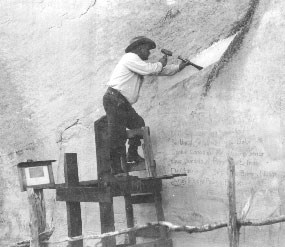
NPS photo The inscriptions and petroglyphs at El Morro are a part of our heritage, and although they are very old, they will not be here forever. Sand grains are washed away, rocks crumble and fall, and lichens and clay deposits cover the historic carvings.

NPS photo These first, well-intended though intrusive attempts to preserve the inscriptions ended in the 1930s, though even today you will see remnants of the darkening technique in some of the Spanish carvings. |
Last updated: May 6, 2025
